Post by cofi on Apr 15, 2008 15:39:49 GMT
[shadow=red,left,300]Stevie Ray Vaughan[/shadow]
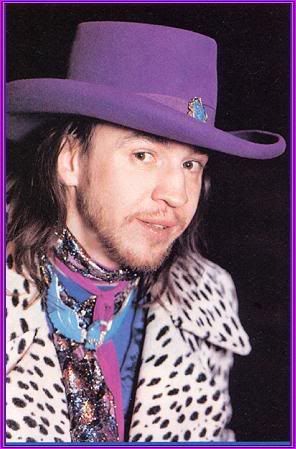
Stevie Ray Vaughan (SRV)
Born October 3, 1954
Dallas, Texas, USA
Died August 27, 1990 (aged 35)
East Troy, Wisconsin, USA
Alias(es) SRV (initials)
Genre(s) Electric blues
Blues Rock
Affiliation(s) Double Trouble
Label(s) Epic Records
Notable guitars Lenny/"'Number One'"
Years active 1975 - 1990
Stephen ("Stevie") Ray Vaughan (October 3, 1954 – August 27, 1990), born in Dallas, Texas, was an American blues guitarist. His broad appeal made him one of America's most influential electric blues guitarists. In 2003, Rolling Stone Magazine ranked Stevie Ray Vaughan #7 in their list of the 100 Greatest Guitarists of All Time.[1] He was the younger brother of Jimmie Vaughan.

Life and career
Early life
Vaughan was born and raised in the Oak Cliff neighborhood of Dallas, Texas. Neither of his parents had any strong musical talent but were avid music fans. They would take Vaughan and his older brother Jimmie to concerts to see Fats Domino, Jimmy Reed, and Bob Wills.
Even though Vaughan initially wanted to play the drums as his primary instrument, he was given a guitar when he was eight years of age. Vaughan's brother, Jimmie Vaughan, gave him his first guitar lessons. Vaughan later quoted in Guitar Player Magazine that " My brother Jimmie actually was one of the biggest influences on my playing. He really was the reason why I started to play, watching him and seeing what could be done." After his brother showed him a few basic chords, Vaughan taught himself to play. He played entirely by ear and never learned how to read sheet music. By the time he was 13 years old he was playing in clubs where he met many of his blues idols. A few years later he dropped out of Kimball High School and moved to Austin to pursue music. Vaughan's talent caught the attention of guitarist Johnny Winter, and blues-club owner Clifford Antone.
Adult Life and Career
Vaughan's first recording band was called Paul Ray and the Cobras. They played at clubs and bars in Austin during the mid-1970s, and released one single.[2] Vaughan later recorded two other singles under the band name The Cobras.[3] Following the break-up of The Cobras, he formed Triple Threat in late 1975, which included bassist Jackie Newhouse, drummer Chris Layton, vocalist Lou Ann Barton, and sax player Johnny Reno. Barton left the band in 1978 to pursue a solo career, followed by Reno in 1979. The three remaining members started performing under the name Double Trouble, inspired by an Otis Rush song of the same name. Vaughan became the band's lead singer.
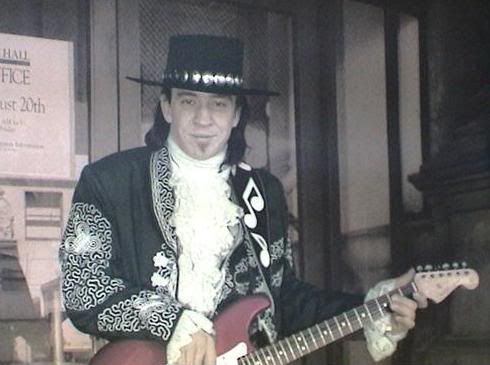
Tommy Shannon, the bass player on Johnny Winter's early albums, replaced Newhouse in 1981. A popular Austin act, Vaughan soon attracted the attention of musicians David Bowie and Jackson Browne. Both Browne and Bowie first caught Vaughan at the 1982 Montreux Jazz Festival, where some members of the audience booed the band, because they disliked Double Trouble's hard blues sound. (The crowd response was quite different when they were invited to headline "Blues Night" at the festival again in 1985.)
In November, 1982, Vaughan recorded in Jackson Browne's studio in downtown Los Angeles. The recordings were brought to the attention of A&R man, John Hammond and became Texas Flood. Later, Bowie then featured Vaughan on his 1983 album Let's Dance.[4] Vaughan was also asked to go on tour with Bowie, but declined in order to focus his efforts on Double Trouble.
The band's critically acclaimed first album, Texas Flood (1983), produced by John Hammond, featured the top-20 hit "Pride and Joy" and sold 500,000 copies, earning the band a Gold Record. As well as this the album was nominated for a Grammy and Rude Mood was nominated for best rock instrumental.
The band's next album, Couldn't Stand the Weather, was recorded in January of 1984. During the summer of 1984, Vaughan and Double Trouble appeared on numerous TV shows, including Rockpalast, Much Music, and Solid Gold. During the Grammy awards of 1984 Stevie, along with George Thorogood presented Chuck Berry with a lifetime achievement award.
In late September, the band rehearsed at the Caravan of Dreams in Fort Worth, Texas for their Carnegie Hall show on October 4, 1984. They had velvet mariachi-style suits made specially for the show. The appearance featured guests Jimmie Vaughan, Roomful of Blues horns, Dr. John, Angela Strehli, and George Rains.
In late January 1985, the band took their first and last Japanese tour. In March, the band started to produce their third album Soul to Soul. Reese Wynans, a former keyboardist of Delbert McClinton's band, was added to the band not long after. With the addition of Reese the title of the band was changed to Stevie Ray Vaughan and Serious Trouble, however no album was released under this modified title. The album's production lasted for two months. Soul to Soul was released on September 30, 1985.
Drug addiction and alcoholism took a toll on Vaughan in mid-1986. Cocaine and Crown Royal whiskey were among his addictions. After becoming acutely ill in Germany while on tour, Vaughan managed to struggle through three more shows and was finally admitted into a hospital in London. He then flew to Atlanta, Georgia to a rehabilitation center. He eventually recovered fully from his addictions and became a teetotaler.
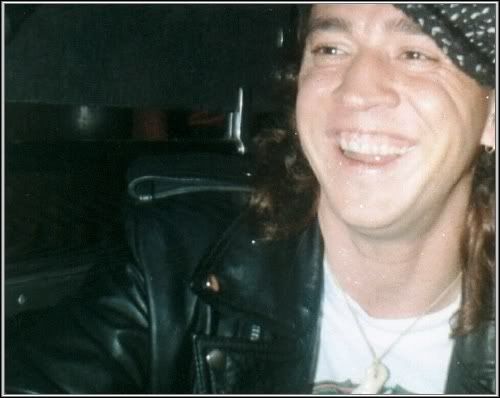
Upon his return from rehab, Vaughan did a number of works with other artists including Dick Dale, Jennifer Warnes, and Stevie Wonder.
In 1988, Vaughan continued to tour with Double Trouble throughout Scandinavia. Vaughan and Double Trouble recorded In Step in February of 1989, which was their fourth studio album since 1985 and is praised by some as the band's best work since Texas Flood. The album won a Grammy Award for Best Contemporary Blues Album. Vaughan shared a headline tour with guitarist Jeff Beck in the fall of 1989.
Stevie is well-known for playing many Jimi Hendrix songs in his own way, (rearanging them) e.g. Little Wing and Voodoo Child (Slight Return).
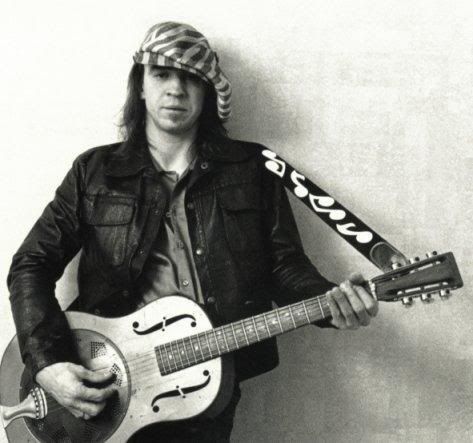
Death
On August 25 and 26, 1990, Vaughan and Double Trouble played shows at Alpine Valley Music Theatre in East Troy, Wisconsin. At the end of the show, Eric Clapton introduced Buddy Guy, Robert Cray, and Jimmie Vaughan, along with Stevie Ray Vaughan. All of the musicians played a 15-minute rendition of "Sweet Home Chicago". After the song ended, all the guitarists hugged and went backstage.
Double Trouble drummer, Chris Layton, recalls his last conversation with Vaughan backstage. He then remembers when Vaughan said he had to call his girlfriend, Janna Lapidus, back in Chicago. He headed out the door to the helicopters.
The musicians expected a long bus ride back to Chicago. Vaughan was informed that three seats were open on one of the helicopters returning to Chicago with Clapton's crew, enough for Vaughan, Jimmie Vaughan, and Jimmie Vaughan's wife Connie. It turned out there was only one seat left, which Stevie Ray Vaughan requested from his brother, who obliged. Taking off into deep fog, the helicopter crashed moments later into a ski slope on the side of a hill within the Alpine Valley Resort. Vaughan, the pilot, and two members of Clapton's crew died on impact. No one realized that the crash had occurred until the helicopter failed to arrive in Chicago, and the wreckage was only found with the help of its locator beacon.[5] The main cause of the crash was believed to be pilot error.[6] The next morning Stevie Ray Vaughan's brother Jimmie and good friend Eric Clapton were called to identify the bodies.
The media initially reported that Vaughan and his band had been killed in the crash. Chris Layton saw this on the news and had security let him into Vaughan's motel room. Layton saw that the bed was made and the clock radio was playing the Eagles' song, "Peaceful, Easy Feeling", which includes the lyrics "I may never see you again". Layton and Shannon then called their families to let them know they were okay.
Stevie Ray Vaughan is interred in the Laurel Land Memorial Park, Dallas, Texas.
Posthumous events and recognition
Vaughan memorial at Town Lake, in Austin, Texas.September 1990 saw the release of Family Style. The 1991 compilation album The Sky Is Crying was the first of several posthumous Vaughan releases to achieve chart success. Jimmie Vaughan later co-wrote and recorded a song in tribute to his brother and other deceased blues guitarists, entitled "Six Strings Down". Many other artists recorded songs in remembrance of Vaughan, including Eric Johnson,[8] Buddy Guy and Steve Vai (The track 'Jibboom'of the album 'The Ultra Zone' recorded in 1999).
In 1991, Texas governor Ann Richards proclaimed October 3, Vaughan's birthday, to be "Stevie Ray Vaughan Day." An annual motorcycle ride and concert in Central Texas benefits the Stevie Ray Vaughan Memorial Scholarship Fund.
In 1992, the Fender Musical Instruments Corporation released the Stevie Ray Vaughan Signature Stratocaster, which Vaughan had helped design. It was a reproduction of his battered 1959 Fender Stratocaster, which he had affectionately named "Number One" (and sometimes referred to as his "first wife"). As of 2006, the model is still in production. It depicts "Number One" as it would have been brand-new in 1963, though when Vaughan bought it in 1974 it was already badly weathered. In 2004, Fender also released a limited edition exact replica of "Number One"
Wikimedia Commons has media related to:
Stevie Ray Vaughan Memorial StatueIn 1994, the city of Austin erected the Stevie Ray Vaughan Memorial Statue at Auditorium Shores on Town Lake, the site of a number of Vaughan's concerts. It has become one of the city's most popular tourist attractions.
Musicians such as John Mayer, Robert Randolph, Kenny Wayne Shepherd, Colin James, Jonny Lang, Los Lonely Boys, Al Reid, Mike McCready and Eric Johnson have cited Vaughan as an influence.
Vaughan's name is mentioned as one of the upcoming acts in Stephen King's short story You Know They Got a Hell of a Band, about a town inhabited by late music legends.
In 2008, Stevie Ray Vaughan will become eligible for the Rock and Roll Hall of Fame.
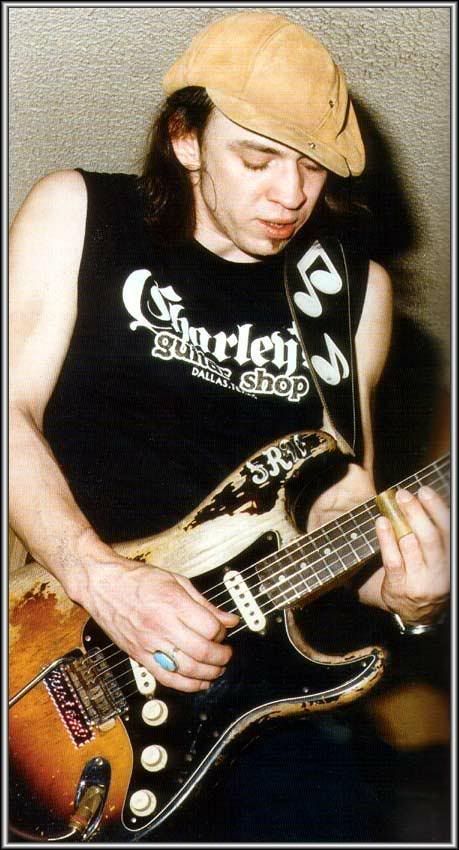
Musical influences and style
Vaughan's blues style was strongly influenced by many blues guitarists. Foremost among them were Albert King, who dubbed himself Stevie's "godfather", Otis Rush, Buddy Guy, and Jimi Hendrix. He was also strongly influenced by Lonnie Mack. Stevie Ray Vaughan, who had idolized Mack since childhood, produced Mack's widely-acclaimed and commercially successful come-back album "Strike Like Lightning" in 1984. Vaughan is recognized for his distinctive guitar sound, which was partly based on using heavy guitar strings (anything from thirteen-gauge to 16-gauge) that he tuned down one half-step. Vaughan's sound and playing style, which often incorporated simultaneous lead and rhythm parts, drew frequent comparisons to Hendrix; Vaughan covered several Hendrix tunes on his studio albums and in performance, such as "Little Wing", "Voodoo Child (Slight Return)", and "Third Stone from the Sun". He was also heavily influenced by Freddie King, another Texas bluesman, mainly in the use of tone and attack; King's heavy vibrato can clearly be heard in Vaughan's playing. Another stylistic influence was Albert Collins. By utilizing his index finger as a pick a la Albert Collins, he was able to coax various tonal nuances from his amps
Vaughan preferred to make use of the immediate tonal capabilities of his guitar amplifiers, adding few effects. His effects in the mid-80's included the Ibanez Tube Screamer, a Vox wah-wah pedal, and a MXR Loop Selector. Contrary to popular belief SRV never employed the use of a flanger/chorus effect. Vaughan was also well known for using the Fender Vibratone speaker cabinet. He acquired one in January 1984 and used about 3 of these throughout his career until his death. Despite rumors, Vaughan has never used a real Leslie speaker in his career. He also used loud volumes for dynamic, coaxing effects from the natural overdriven performance of his amplifiers.
Vaughan's guitars and musical equipment

Stevie Ray's main guitars were Fender Stratocasters. His most famous was a sunburst 1963 Strat with a Brazilian rosewood veneer fingerboard fretted with Dunlop 6100 Jumbo fretwire (an equilvalent to this fretwire is Stewart-MacDonald 0150 fretwire); it had 1962 stamped on the neck and body, but 1959 written on the pickups leading Vaughan to mistakenly believe it was assembled in 1962 from 1959 parts. On this particular guitar, he also had a left-handed tremolo installed. This guitar was known as Number One. It had a D-shaped thick neck that was perfect for his large hands and thick fingers. It possessed a deep, dark growl of a tone that was immediately identifiable. The guitar also had a prismatic sticker just below the bridge with the word "Custom" in script letters. This sticker was given to Vaughan soon after he bought it in 1973. Vaughan also had some custom-made stick-on plastic letters reading "SRV" on one of the body cavities. Even though Number One used all stock Fender Strat parts, about the only original parts it possessed by 1990 were the body and the pickups. Over the years, Vaughan and Rene Martinez, his guitar tech, replaced the pickguard, tremolo, and neck. The guitar was meticulously examined by Fender Custom Shop workers to gather specifications for a run of 100 exact copies in early 2004.[citation needed] The pickups were never overwound purposely, but were from a batch of pickups made at Fender in 1959 that had been overwound by mistake, producing Number One's distinctive sound. The neck was damaged during a stage accident, and a spare was used from another of Vaughan's Stratocasters. After he died, the original neck was put back on and the guitar was given to his brother.
Lenny was a 1964 maple-neck that was named after his wife, Lenora. It had a very bright, thin sound. Supposedly, Vaughan found this guitar in a pawnshop, but couldn't afford to buy it. One of Vaughan's roadies, Byron Barr, bought it and he and Lenora presented it to Vaughan for his birthday in 1976. According to the story, Lenora was supposed to pay Byron for the guitar; she started a pool party with her friends to collect the money, but it was Vaughan who eventually settled the debt, with cash and a leather jacket. Its neck was originally a thin rosewood, but Vaughan replaced it with a thicker non-Fender maple neck. Lenny can be seen and heard on "Live at the El Mocambo". He played it sometimes at the end of the set during the encore, playing the song of the same name, Lenny. Vaughan also used the guitar during the song "Riviera Paradise", this can also be seen and heard on the DVD "Live From Austin Texas". After Stevie's divorce from his wife and the meeting of the new love in his life, Janna Lapidus, Vaughan started calling this guitar "Scotch". Despite other information from various sources, this shouldn't be confused with the butter-colored guitar, as described below.
The 1961 butter-colored Strat was bought by Stevie in the fall of 1985. He gave away another guitar and bought this piece. It was all stock except for the tiger-striped pickguard, made by Rene Martinez. He usually used this guitar on the song "Leave My Girl Alone".
Charley was a custom-made Stratocaster built for him by the late Charley Wirz, a friend and owner of Charley's Guitar Shop in Dallas, Texas. It was made for Stevie in late 1983, but had a neck plate with the engravement "More In '84". It had three Danelectro lipstick tubes and it had a hardtail bridge. The guitar was also rewired with 1 tone knob and 1 volume. This guitar was said by Stevie to have a lot of "bite" in the guitar's tone.
Red was a 1962 Strat bought in late 1983 at Charley's Guitar Shop. The finish was originally sunburst, but was repainted fiesta red. In 1986, a left-handed neck was installed on this guitar to emulate the sound and feel of Jimi Hendrix.
Main was a custom-made Hamiltone Strat given to Vaughan as a gift from Billy Gibbons of ZZ Top on April 29, 1984. The guitar was originally supposed to be made in 1979 with "Stevie Vaughan" inlayed with mother-of-pearl in the fingerboard. The plan was crushed when Vaughan started using his middle name. It had cream-colored plastic binding around the body and neck. It was also constructed of 2-piece maple wood and originally had white EMG pickups, an onboard preamp, and Gibson-style "bell" knobs. After the making of the "Couldn't Stand The Weather" music video, Rene Martinez, Vaughan's guitar tech, rewired it with a standard Strat system. The guitar also had a jazz type tone as described by Stevie Ray.
Butter was the original yellow Strat originally owned by Vince Martell of Vanilla Fudge. The guitar was repainted yellow and donated it to Charley's Guitar Shop. They painted it yellow and Stevie bought it in 1981. It had one tone knob and one volume knob. The guitar was stolen from him in 1987 and never recovered.
Vaughan also played a guitar made by deceased Minneapolis, Minn., luthier, Roger Benedict. A semi-hollow, Alder-built guitar called the Groove Master was a model of choice for Vaughan. It is a seafoam-green Stratocaster-shaped guitar with three lipstick pickups.
In total, Vaughan owned 34 guitars thoughout his career.
Jimmie Vaughan has possession of all of his brothers guitars, save for the only one released to the public, Lenny. It was sold in the Eric Clapton guitar auction for more than $600,000.
Around early 1985, his pedal board consisted of a Ibanez TS-9 Tube Screamer, MXR Loop Selector, Vox Wah-Wah, and the Fender Vibratone's footswitch.
His amps around this time were 2 black-face Fender Vibroverbs, Fender Vibratone, a black-face Super Reverb, and 2 silver-face Twin Reverbs.
In a recent publication of Guitar World, they revealed a Soldano SLO-100 amp head that Vaughan comissioned before he died.
Here is something I was reading the other day about his gear,
interesting

Stevie’s guitars were all pre-’63 model Fender Stratocasters, except for “Charley” (outfitted with the Danelectro “lipstick tube” pickups, it was made from kit parts at Charley’s Guitar Shop in 1984). They all have names, too: Number One, Red, Butter Scotch, Charley, and Lennie. The only significant change from the stock on these Strats has been the addition of 5-way switches and a good coat of shielding paint in the control cavities. Number One, the beat-up sunburst that we all know, is Stevie’s main squeeze.
I have read somewhere that he used heavy Gauge strings,
 cant remember where i read it,
cant remember where i read it, that he used to really mash up his finger tip's, with bending so much on the heavy Gauge string's, that he used to coat his finger tips with super glue, (some call it rapid glue) Ouch,


Stevie tunes his guitar down a half-step and uses GHS Nickel Rockers measuring .013, .015, .019 (plain), .028, .038, and .058. On this particular day, Rene had substituted an .011 for the high E to keep down the sore fingers that blues bends can cause.

